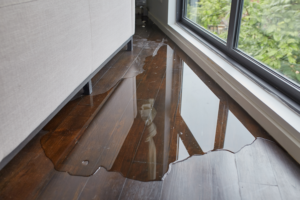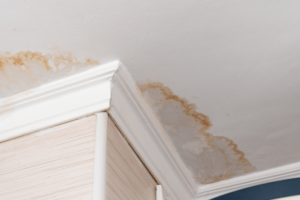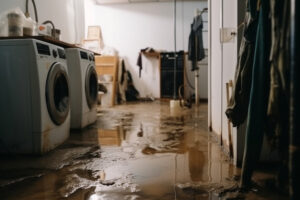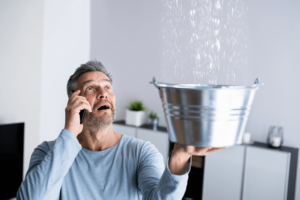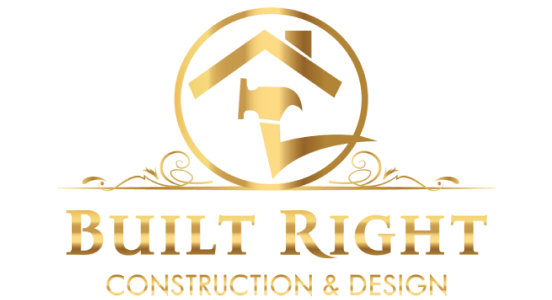Did you know that effective water damage restoration plays a crucial role in preventing mold and mildew growth? It’s true! When faced with flooding or other water-related incidents, taking immediate action is essential to minimize the risk of mold and mildew. But why is this so important?

Excess moisture creates an ideal breeding ground for mold and mildew. These unwelcome intruders can take hold on various surfaces, including walls and furniture, causing not only unsightly stains but also potential health hazards. This is where professional water damage restoration services become invaluable.
By addressing water damage promptly, experts can prevent further infiltration of moisture into your home’s foundation or structures. This proactive approach halts the growth of mold and mildew, ensuring the protection of your property and your well-being.
So, if you’re facing water damage, don’t delay—get in touch with trusted professionals who specialize in swift and efficient water damage restoration. They will ensure that mold and mildew have no opportunity to settle in your home, providing you with peace of mind.
Essential Steps To Stop A Leak
Identifying the source of a leak is crucial in preventing further water damage. When you notice a leak, it’s important to take immediate action by following these essential steps:
- Shut off the main water supply: Locate the main water valve and turn it off to stop the flow of water. This step is vital in halting the leak and minimizing potential damage.
- Contact a professional plumber: Reach out to a skilled plumber who can effectively fix the leak. Plumbers have the expertise to assess the situation, provide appropriate solutions, and ensure that repairs are carried out correctly.
By taking these necessary precautions, you can prevent extensive water damage caused by leaks. Additionally, here are some additional measures you can consider:
- Check your walls for signs of moisture or discoloration as they may indicate hidden leaks.
- Inspect your plumbing system regularly for any potential sources of leaks such as dripping faucets or faulty pipes.
- If you suspect a leak in your water tank, contact a professional immediately to avoid significant damage.
- Be mindful of excessive water usage, as even small drips can add up to gallons wasted over time.
Remember that time is of the essence when dealing with leaks. The longer they go unaddressed, the more likely they are to cause mold and mildew growth. Act promptly to minimize any potential risks associated with water damage.
Effective Technique: Pulling Up Carpeting
Preventing the proliferation of mold and mildew in your home is paramount when dealing with water damage. One essential step towards this is the prompt removal of wet carpeting, which serves as a fertile ground for these harmful fungi. However, executing this task necessitates careful handling to avoid further damage.
Here are some vital pointers when undertaking carpet removal:
- Shield the underlying floor: It’s crucial to protect the floor beneath the carpet prior to starting the removal process. This might require the gentle use of tools like pliers or a pry bar to avoid any scrapes or dents on the floor.
- Ensure proper disposal of wet carpets: Wet carpets can potentially harbor bacteria and other hazardous substances. Therefore, after removal, it’s imperative to dispose of it appropriately. A good practice is to encase it in plastic bags before throwing it away.
- Adopt safety measures: When dealing with areas affected by water damage, don protective gloves and clothing to minimize contact with possibly contaminated materials. This precautionary step helps mitigate any health risks associated with handling damp or moldy items.
Bear in mind that mold and mildew can thrive on a variety of surfaces, not limited to carpets. This includes ceiling tiles, furniture, walls, or paper-based materials like wallpaper. Consequently, if water damage has impacted multiple rooms or hard surfaces in your home, you might want to consider enlisting the help of professional water damage restoration services.
Using Paint With Mildewcide In Damp Areas
Preventing mold and mildew growth in damp areas can be achieved by applying paint with a mildewcide, which inhibits their development. It is important to use high-quality paint products specifically designed for moisture-prone spaces to create a protective barrier against these unwanted invaders.
Regular inspection of painted surfaces is crucial in order to detect any signs of mold or mildew early on. This proactive approach allows you to address the issue promptly before it becomes a major problem. Keep an eye out for visible spots, discoloration, or musty odors, as these can indicate the presence of mold or mildew.
Here are key points to remember when using paint to prevent mold and mildew in damp areas:
- Choose paints with mildewcide additives: Look for paints labeled as having mildewcide properties. These additives help inhibit the growth of mold and mildew on painted surfaces.
- Opt for high-quality moisture-resistant paints: Invest in top-notch paint products designed specifically for moisture-prone areas. These paints offer better protection against mold and mildew.
- Apply multiple coats: To enhance defense against mold and mildew, consider applying two or more coats of paint in damp areas like bathrooms, basements, or kitchens.
- Maintain proper ventilation: Adequate airflow is crucial in preventing excess moisture buildup, reducing the chances of mold and mildew growth. Ensure that rooms with damp conditions have proper ventilation options such as exhaust fans or open windows.
By implementing these preventive measures and regularly inspecting your painted surfaces, you can effectively combat the risk of mold and mildew development in the damp areas of your home.
Tips For Cleaning And Disposing Of Water Damage
When it comes to dealing with water damage, it is crucial to take the right steps to clean and dispose of affected areas properly. Here are some informative tips to guide you through the process:
- Wear protective gear: Before starting the cleanup process, prioritize your safety by wearing gloves and masks. This protective gear will shield you from potential health hazards associated with handling wet items, such as bacteria or contaminants present in the water.
- Thoroughly dry affected items: After the initial cleanup, ensure that all affected items are thoroughly dried. This step is important in assessing whether they can be salvaged or if they have suffered irreparable damage due to prolonged exposure to moisture. Complete drying also helps prevent the growth of mold and mildew, which can thrive in damp environments.
- Follow proper guidelines for disposing of blackwater-contaminated materials: If flood water or sewage has contaminated porous items like carpets or upholstery, it is vital to adhere to specific guidelines for their disposal. Blackwater can contain harmful bacteria and pathogens that pose serious health risks if not handled and disposed of correctly.
By following these informative tips, you can effectively address water damage, minimize the risk of mold and mildew growth, and ensure the safety of yourself and your home. Remember, taking preventive measures is key to maintaining a healthy living environment.
Utilizing Dehumidifiers For Continued Drying
Dehumidifiers are essential in the prevention of mold and mildew growth as they remove excess moisture from the air, aiding in the thorough restoration of affected areas. To optimize the effectiveness of dehumidifiers, it is important to strategically place them throughout the space.
Here are some informative points to consider when using dehumidifiers:
- Strategic Placement: Position dehumidifiers strategically in areas where moisture is concentrated or where water damage has occurred. This targeted placement ensures efficient extraction of excess moisture from the air, promoting faster drying and preventing the growth of mold and mildew.
- Regular Maintenance: Regularly empty the collected water from dehumidifier tanks to maintain optimal performance. Neglecting this task can hinder the dehumidifiers’ ability to effectively remove moisture from the air. By emptying the tanks as needed, you ensure that the dehumidifiers continue to function at their best.
- Supporting Equipment: Consider using additional equipment such as dry vacuums, HVAC systems, bath fans, and standing fans in conjunction with dehumidifiers. These complementary tools can enhance the overall drying process by improving ventilation and airflow within the affected areas, further preventing mold and mildew growth.
By implementing these measures and using dehumidifiers correctly, you can effectively prevent the growth of mold and mildew after water damage occurs. Remember, proper drying is crucial for restoring your space to its pre-damage condition and maintaining a healthy environment.
Make the most of dehumidifiers and the appropriate equipment to ensure a successful water damage restoration process!
Understanding Conditions For Mold Growth
Mold growth is a widespread issue in residential and commercial buildings. To effectively prevent the proliferation of mold and mildew in your space, it is crucial to have a comprehensive understanding of the conditions that foster their growth. Consider the following informative points:
- Moisture, Organic Material, Oxygen, and Suitable Temperatures: Mold requires these four elements to thrive and reproduce. Without them, mold spores cannot develop into a full-blown infestation. By recognizing the significance of these factors, you can take appropriate measures to impede mold growth.
- High Humidity Levels: Mold thrives in environments with elevated humidity levels. Excess moisture in the air creates an ideal habitat for mold to flourish. It is imperative to actively manage indoor humidity levels to prevent mold infestations. This involves employing techniques such as proper ventilation, dehumidifiers, and timely resolution of any sources of moisture.
- Identifying and Addressing Sources of Moisture: Effectively preventing mold growth necessitates the identification and mitigation of all sources of moisture within your living or working space. This includes promptly fixing leaky pipes, addressing water damage in a timely manner, ensuring adequate ventilation in areas prone to dampness, and utilizing dehumidifiers when necessary. By eliminating or mitigating these moisture sources, you significantly reduce the risk of mold growth.
- Preventing Microbial Growth: In addition to its unsightly appearance, mold can pose health problems. Specific types of mold release allergens and irritants that can cause respiratory issues and other health concerns. By proactively preventing microbial growth through effective moisture control, you can maintain a healthier living or working environment.
By comprehending the conditions conducive to mold growth and taking proactive measures to prevent them, you can create a safer and more comfortable space, free from the detrimental effects of mold. Remember to remain vigilant in identifying and addressing signs of water damage or excessive moisture to protect your space from undesirable bacteria and mold infestations.
Controlling Indoor Moisture: Key To Mold Prevention
Proper ventilation is a crucial factor in effectively preventing mold growth. By ensuring adequate airflow throughout your home, you can effectively control indoor humidity levels, thereby reducing the risk of moisture buildup and discouraging the development of mold. It is important to promptly address plumbing leaks and any water intrusion issues to prevent excess moisture from accumulating indoors.
Regular monitoring of relative humidity levels is vital for effective mold prevention. Utilizing a moisture meter, you can keep track of the humidity in different areas of your house. Aim to maintain relative humidity below 60% to discourage mold growth, as high humidity provides an ideal environment for mold spores to thrive.
Insulation also plays a significant role in preventing mold and mildew. Properly insulating your home helps regulate temperature and reduces condensation on surfaces, which can contribute to excess moisture buildup.
Porous materials are particularly susceptible to mold growth. Therefore, it is important to exercise extra care when dealing with items such as carpets, upholstery, and wooden furniture. Promptly address any spills or water damage to ensure these materials remain dry and clean.
By implementing these informative measures, you can effectively prevent mold growth and maintain a healthier living environment. Remember to prioritize proper ventilation, monitor humidity levels, ensure insulation, and take necessary precautions with porous materials to minimize the risk of mold and mildew in your home.
Our Take On The Importance Of Preventing Mold And Mildew Through Water Damage Restoration
Preventing the growth of mold and mildew is vital for a healthy and safe living environment. Water damage restoration plays a significant role in this endeavor by tackling the root causes of moisture accumulation and implementing strategies to prevent further damage. Essential steps like promptly addressing leaks, removing wet carpeting, using mildewcide-infused paint in damp areas, cleaning up water damage thoroughly, and employing dehumidifiers for continuous drying, can dramatically lower the risk of mold proliferation.
Gaining insight into the conditions that encourage mold growth is vital for its effective prevention. Regulating indoor humidity levels is a crucial factor in preventing mold. By proactively monitoring and controlling humidity levels, you can create an unfavorable environment for mold spores.
For successful mold and mildew prevention, swift action after water damage is critical. Delaying restoration efforts can lead to more severe issues in the future. Therefore, it’s advisable to act quickly and seek professional help when necessary.
Remember, preventing mold and mildew does more than protect your property; it also ensures the health and safety of you and your family. Don’t wait until it’s too late – start taking preventive measures today!
Sources:
https://www.epa.gov/mold/brief-guide-mold-moisture-and-your-home#tab-2
Rising From The Ashes: Reclaim Your Life With Expert Water Damage Restoration Services
Has a devastating fire or water damage turned your life upside down? The aftermath can be overwhelming and leave you feeling stressed. But fear not, because at Got Damage?, we specialize in top-notch fire and water remediation services that will help you restore your property and bring peace back into your life.
With decades of experience, we’ve successfully recovered numerous properties from fire and smoke damage ravages. When the smoke clears and the flames are extinguished, our team of experts stands ready to step in and provide exceptional restoration services.
We understand that home restorations go beyond fixing physical damage; they’re about creating a space where your family can thrive for years. That’s why we take pride in being a trustworthy team that guides you through decision-making. We’ll help you strike the perfect balance between using quality materials and staying within your budget, ensuring that the end result exceeds your expectations.
But our expertise doesn’t stop at fire and smoke damage. We’re also your go-to experts in mold remediation, water damage repair, storm damage, and emergency situations. No matter the nature of the damage, we have the knowledge and skills to tackle it head-on and restore your property to its former glory.
Don’t let stress and devastation linger any longer. Trust Got Damage? to be your partner in the restoration journey. We’re proud to serve the SF East Bay area and will assist you in filing insurance claims, ensuring a smooth and hassle-free process.
Take the first step towards reclaiming your peace of mind by contacting us today. Let our experienced team handle the challenges while you focus on rebuilding and moving forward. Together, we’ll breathe new life into your property and create a brighter future.

